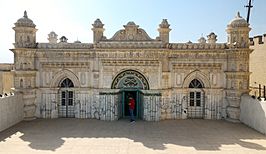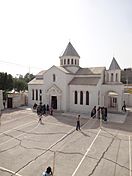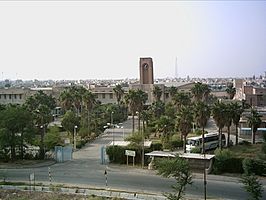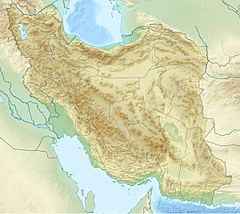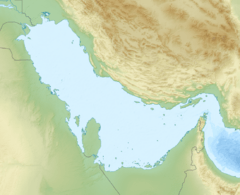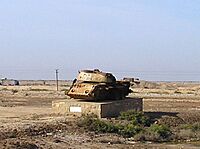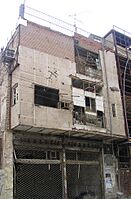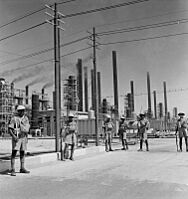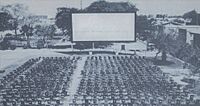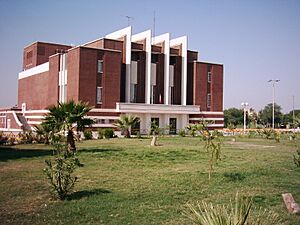Abadan, Iran facts for kids
Quick facts for kids
Abadan
Persian: آبادان
|
|
|---|---|
|
City
|
|
| Ābādān | |
| Country | Iran |
| Province | Khuzestan |
| County | Abadan |
| District | Central |
| Area | |
| • Land | 1,275 km2 (492 sq mi) |
| Elevation | 3 m (10 ft) |
| Population
(2016)
|
|
| • Total | 231,476 |
| • Population Rank in Iran | 40th |
| Demonym(s) | Abadani (en) |
| Time zone | UTC+03:30 (IRST) |
| Area code(s) | (+98) 061 |
| Climate | BSk |
Abadan (Persian: آبادان) is a city in the southwest of Iran. It is located in the Khuzestan province, on Abadan Island. This island is about 68 kilometers (42 miles) long. It sits between two waterways: the Arvand to the west and the Bahmanshir to the east. Abadan is also about 53 kilometers (33 miles) from the Persian Gulf. It is quite close to the border with Iraq.
Contents
What's in a Name?
The name "Abadan" has a long history. The Greek geographer Marcian called it "Apphadana." Another geographer, Ptolemy, mentioned "Apphana" as an island near the mouth of the Tigris River. This is where Abadan Island is today.
One idea is that the name comes from old Persian words. "Ab" means water, and "pā" means guard or watch. So, it could mean "coastguard station."
Later, during Islamic times, some people thought the name came from a person. They said a man named "Abbad bin Hosayn" founded a military base there. But this is likely just a folk story. The Persian name became official in 1935.
A Look Back in Time
Abadan grew into an important port city under the rule of the Abbasids. It was known for trading salt and woven mats. Over time, the river delta filled with mud, pushing the town further from the water. In the 1300s, a traveler named Ibn Battutah described Abadan as a small port on a flat, salty plain.
For many years, different states argued over who owned Abadan. In 1847, Persia (now Iran) gained control of it from the Ottoman Empire. From the 1600s, the island was part of the lands of the Arab Ka'ab tribe.
The Rise of Oil
The 1900s brought a big change: rich oil fields were found nearby. In 1909, the Anglo-Persian Oil Company started building a huge oil refinery in Abadan. It was finished in 1912. This refinery quickly became one of the largest in the world by 1938.
During World War II, Abadan was important for sending supplies to the Soviet Union. It was a key place for oil, which was vital for the war effort.
In 1951, Iran took control of all its oil properties. This caused some problems, and the refinery stopped working for a while. After a change in government, a group of international oil companies managed the oil production until 1973. Then, Iran's own national oil company took over completely.
Modern Challenges
Abadan played a role in the Islamic Revolution in Iran. In 1978, a tragic fire happened at the Cinema Rex movie theater. This event, along with others, helped push the revolution forward.
In September 1980, the Iran–Iraq War began with a surprise attack on Khuzestan province. Abadan was under attack for 11 months. Iraqi forces bombed the city and the oil refinery. Even though it was badly damaged, Abadan was never captured. Before the war, about 300,000 people lived in Abadan. But almost everyone left to find safety elsewhere in Iran during the war.
After the war ended in 1988, rebuilding the city and its refinery was a huge task. The refinery was working at only 10% of its normal capacity. By 1997, it was back to its pre-war production levels.
-
The burnt-out shell of an Iraqi tank, now a monument to the Iran–Iraq War.
Abadan Today
To celebrate 100 years of oil refining in Abadan, city officials are planning an oil museum. The Abadan oil refinery was even shown on Iran's 100-rial banknotes in the past.
Today, Abadan is a "free zone city." This means it has special rules to encourage trade and business. It's also an important city for travel between Iran and Iraq.
How Many People Live Here?
| Year | People |
|---|---|
| 1910 | 400 |
| 1949 | 173,000 |
| 1956 | 220,000 |
| 1980 | 300,000 |
| 1986 | 6 |
| 1991 | 84,774 |
| 2001 | 206,073 |
| 2006 | 217,988 |
| 2011 | 212,744 |
| 2016 | 231,476 |
The city's population almost disappeared during the Iran–Iraq War (1980–1988). In 1986, only 6 people were recorded living there! But people slowly returned. By 1991, over 84,000 people were back. The population has continued to grow, reaching over 231,000 in 2016.
Most people in Abadan are Persian, but the city has been influenced by Arabic culture. There is also an Armenian church in the city center.
Climate
Abadan has a very dry climate, similar to a desert. Summers are extremely hot and dry. Temperatures often go above 45°C (113°F) and can even reach 50°C (122°F). The city also experiences some sand and dust storms each year.
Winters are mild and a bit wet, like spring. It can get cold at night, but it never snows. Winter temperatures are usually around 16–20°C (61–68°F). The highest temperature ever recorded was 53.0°C (127.4°F). The lowest was -4°C (25°F).
| Climate data for Abadan (1991–2020, records 1951–present) | |||||||||||||
|---|---|---|---|---|---|---|---|---|---|---|---|---|---|
| Month | Jan | Feb | Mar | Apr | May | Jun | Jul | Aug | Sep | Oct | Nov | Dec | Year |
| Record high °C (°F) | 29.0 (84.2) |
34.0 (93.2) |
41.1 (106.0) |
43.4 (110.1) |
49.4 (120.9) |
52.2 (126.0) |
53.0 (127.4) |
53.0 (127.4) |
50.1 (122.2) |
45.5 (113.9) |
37.7 (99.9) |
29.8 (85.6) |
53.0 (127.4) |
| Mean daily maximum °C (°F) | 18.4 (65.1) |
21.4 (70.5) |
26.7 (80.1) |
33.2 (91.8) |
40.2 (104.4) |
45.2 (113.4) |
46.8 (116.2) |
46.9 (116.4) |
43.4 (110.1) |
36.7 (98.1) |
26.8 (80.2) |
20.3 (68.5) |
33.8 (92.9) |
| Daily mean °C (°F) | 12.9 (55.2) |
15.4 (59.7) |
20.1 (68.2) |
26.1 (79.0) |
32.5 (90.5) |
36.5 (97.7) |
37.8 (100.0) |
37.3 (99.1) |
33.5 (92.3) |
27.7 (81.9) |
19.6 (67.3) |
14.3 (57.7) |
26.1 (79.1) |
| Mean daily minimum °C (°F) | 7.9 (46.2) |
10.0 (50.0) |
14.1 (57.4) |
19.6 (67.3) |
24.9 (76.8) |
27.8 (82.0) |
29.2 (84.6) |
28.5 (83.3) |
24.8 (76.6) |
20.3 (68.5) |
14.0 (57.2) |
9.2 (48.6) |
19.2 (66.5) |
| Record low °C (°F) | −4.0 (24.8) |
−4.0 (24.8) |
−1.0 (30.2) |
7.0 (44.6) |
12.0 (53.6) |
17.0 (62.6) |
17.0 (62.6) |
19.4 (66.9) |
14.0 (57.2) |
7.0 (44.6) |
−1.6 (29.1) |
−1.0 (30.2) |
−4.0 (24.8) |
| Average precipitation mm (inches) | 32.9 (1.30) |
16.2 (0.64) |
19.5 (0.77) |
12.6 (0.50) |
2.7 (0.11) |
0.1 (0.00) |
0.0 (0.0) |
0.0 (0.0) |
0.0 (0.0) |
7.7 (0.30) |
23.2 (0.91) |
39.6 (1.56) |
154.5 (6.09) |
| Average precipitation days (≥ 1.0 mm) | 4.1 | 2.7 | 2.8 | 2 | 0.6 | 0 | 0 | 0 | 0 | 0.9 | 3 | 3.5 | 19.6 |
| Average relative humidity (%) | 69 | 57 | 48 | 40 | 29 | 22 | 24 | 28 | 31 | 43 | 57 | 68 | 43 |
| Average dew point °C (°F) | 6.7 (44.1) |
5.9 (42.6) |
7.1 (44.8) |
9.6 (49.3) |
10.1 (50.2) |
9.3 (48.7) |
11.6 (52.9) |
13.1 (55.6) |
11.6 (52.9) |
11.8 (53.2) |
9.7 (49.5) |
7.8 (46.0) |
9.5 (49.2) |
| Mean monthly sunshine hours | 201 | 205 | 244 | 243 | 297 | 343 | 341 | 342 | 305 | 270 | 214 | 201 | 3,206 |
| Mean daily daylight hours | 10.4 | 11.1 | 12 | 12.9 | 13.7 | 14.1 | 13.9 | 13.2 | 12.3 | 11.4 | 10.6 | 10.2 | 12.1 |
| Average ultraviolet index | 5 | 6 | 6 | 8 | 9 | 10 | 10 | 10 | 8 | 7 | 5 | 5 | 7 |
| Source 1: NOAA NCEI | |||||||||||||
| Source 2: Iran Meteorological Organization (records), Weather atlas(Daylight-UV) | |||||||||||||
| Climate data for Abadan (1951–2010, records 1951–present) | |||||||||||||
|---|---|---|---|---|---|---|---|---|---|---|---|---|---|
| Month | Jan | Feb | Mar | Apr | May | Jun | Jul | Aug | Sep | Oct | Nov | Dec | Year |
| Record high °C (°F) | 29.0 (84.2) |
34.0 (93.2) |
41.1 (106.0) |
43.4 (110.1) |
49.4 (120.9) |
52.2 (126.0) |
53.0 (127.4) |
53.0 (127.4) |
50.1 (122.2) |
45.5 (113.9) |
37.7 (99.9) |
29.8 (85.6) |
53.0 (127.4) |
| Mean daily maximum °C (°F) | 18.1 (64.6) |
20.9 (69.6) |
25.9 (78.6) |
32.2 (90.0) |
39.2 (102.6) |
43.8 (110.8) |
45.4 (113.7) |
45.4 (113.7) |
42.5 (108.5) |
36.1 (97.0) |
26.8 (80.2) |
19.9 (67.8) |
33.0 (91.4) |
| Daily mean °C (°F) | 12.7 (54.9) |
15.0 (59.0) |
19.4 (66.9) |
25.2 (77.4) |
31.2 (88.2) |
35.2 (95.4) |
36.7 (98.1) |
36.3 (97.3) |
33.0 (91.4) |
27.5 (81.5) |
20.0 (68.0) |
14.3 (57.7) |
25.5 (77.9) |
| Mean daily minimum °C (°F) | 7.3 (45.1) |
9.1 (48.4) |
13.0 (55.4) |
18.1 (64.6) |
23.3 (73.9) |
26.5 (79.7) |
28.0 (82.4) |
27.3 (81.1) |
23.4 (74.1) |
18.9 (66.0) |
13.2 (55.8) |
8.7 (47.7) |
18.1 (64.6) |
| Record low °C (°F) | −4.0 (24.8) |
−4.0 (24.8) |
−1.0 (30.2) |
7.0 (44.6) |
12.0 (53.6) |
17.0 (62.6) |
17.0 (62.6) |
19.4 (66.9) |
14.0 (57.2) |
7.0 (44.6) |
−1.6 (29.1) |
−1.0 (30.2) |
−4.0 (24.8) |
| Average precipitation mm (inches) | 35.5 (1.40) |
20.0 (0.79) |
19.2 (0.76) |
14.4 (0.57) |
3.2 (0.13) |
0.1 (0.00) |
0.0 (0.0) |
0.0 (0.0) |
0.1 (0.00) |
3.9 (0.15) |
20.5 (0.81) |
36.4 (1.43) |
153.3 (6.04) |
| Average rainy days | 4.7 | 3.4 | 3.3 | 2.2 | 0.9 | 0.0 | 0.0 | 0.0 | 0.0 | 0.6 | 2.6 | 4.6 | 22.3 |
| Average relative humidity (%) | 70 | 61 | 51 | 44 | 33 | 26 | 28 | 31 | 34 | 45 | 58 | 69 | 45 |
| Mean monthly sunshine hours | 180.6 | 195.0 | 222.3 | 221.6 | 262.9 | 292.1 | 305.1 | 290.4 | 290.4 | 263.4 | 202.4 | 182.5 | 2,908.7 |
| Source: Iran Meteorological Organization (records), (temperatures), (precipitation), (humidity), (days with precipitation), (sunshine) | |||||||||||||
Economy and Learning
Abadan is important for Iran's oil industry. The Abadan Refinery was built here because of its good location. It started working in 1962 and is one of the largest refineries in the world.
The Abadan Institute of Technology was started in 1939. It trained people to work in the oil refinery. Today, it is part of the Petroleum University of Technology. Abadan also has a University of Medical Sciences.
The city is known for its busy fish market. Locals buy fresh seafood there for many delicious dishes.
Major Companies
- Abadan Oil Refining Co.
- Abadan Petrochemical Company
- Afra Arvand
- Homa Chemistry
- Iranol Oil Company
- KPC Karun
- Pars Opal Co.
- Pasargad Oil
- Shirin Diar Arvand Co.
- Tam Arvand Machine
- U-PVC Novin
- Vina Naghsh Industrial Group
- Yekta Tahviyeh Arvand Co.
Universities
- Abadan University of Medical Sciences
- Islamic Azad University of Abadan
- MehrArvand University
- Petroleum University of Technology
- PNU of Abadan
Places to See
Bridges
- Bahmanshir Bridge at Istgah-e Haft
- Imam Reza Cable Bridge
Mosques
- Rangooniha Mosque
Museums
- Abadan Museum
- Historical and Handwritten Documents Museum
- Abadan Gasoline House Museum
- Oil Museum of Abadan
Church
- St. Karapet Armenian Church
Cinema
- Cinema Naft
- Shirin Movie Theater
Famous People from Abadan
- Ahmad Reza Abedzadeh – football player
- Sussan Babaie – art historian
- Patrik Baboumian – strongman
- Mohsen Bayatinia – football player
- Najaf Daryabandari – writer
- Parviz Dehdari – football coach
- Firoozeh Dumas – writer
- Bizhan Emkanian – actor
- Hamid Farrokhnezhad – actor
- Bahman Golbarnezhad – paralympic racing cyclist
- Farhad Hasanzadeh – poet
- Mehdi Hasheminasab – football player
- Hossein Kanaanizadegan – football player
- Abdolhassan Kazemi – retired football player
- Mojahed Khaziravi – football player
- Martik – singer
- Gholam Hossein Mazloumi – football coach
- Parviz Mazloumi – football coach
- Manouchehr Mohammadi – film producer
- Amir Naderi – director
- Hossein Nassim – water polo coach
- Abie Nathan – peace activist
- Zoya Pirzad – writer
- Hamid Rashidi – lawyer
- Nasser Taghvai – director
- Hossein Vafaei – snooker player
- Cyma Zarghami – TV producer
Getting Around
By Plane
Abadan has an international airport called Abadan-Ayatollah Jami International Airport. You can fly there on different airlines.
By Train
The closest train station is in Khorramshahr, about 10 kilometers (6 miles) north of Abadan. You can take trains from cities like Ahvaz, Tehran, and Mashhad.
Sports
Abadan has a football (soccer) club called Sanat Naft Abadan F.C.. They play in Iran's top football league. Their home stadium is Takhti Stadium.
Sister Cities
Abadan has special friendly relationships with these cities:
See also
 In Spanish: Abadán para niños
In Spanish: Abadán para niños


